NRSG210 Essay: Factors Influencing Domestic Violence Incidence
VerifiedAdded on 2023/06/08
|8
|2300
|235
Essay
AI Summary
This essay examines domestic violence as a global issue with significant negative impacts on mental health and wellbeing. It explores the influence of socioeconomic factors, such as poverty, unemployment, and income gaps, on the prevalence of domestic violence, referencing both international and Australian sources. The essay also delves into the psychological factors, including childhood experiences of violence, personality disorders, and the role of trauma, stress, fear, and control, analyzing these factors in relation to both perpetrators and victims. The discussion includes insights into marital status, social isolation, and the dynamics of aggression, providing a comprehensive overview of the complex interplay of factors contributing to domestic violence. The essay concludes by highlighting the multifaceted nature of domestic violence, emphasizing that both men and women can be perpetrators and victims, and that a range of economic, social, and psychological factors contribute to the incidence of violence within intimate relationships.
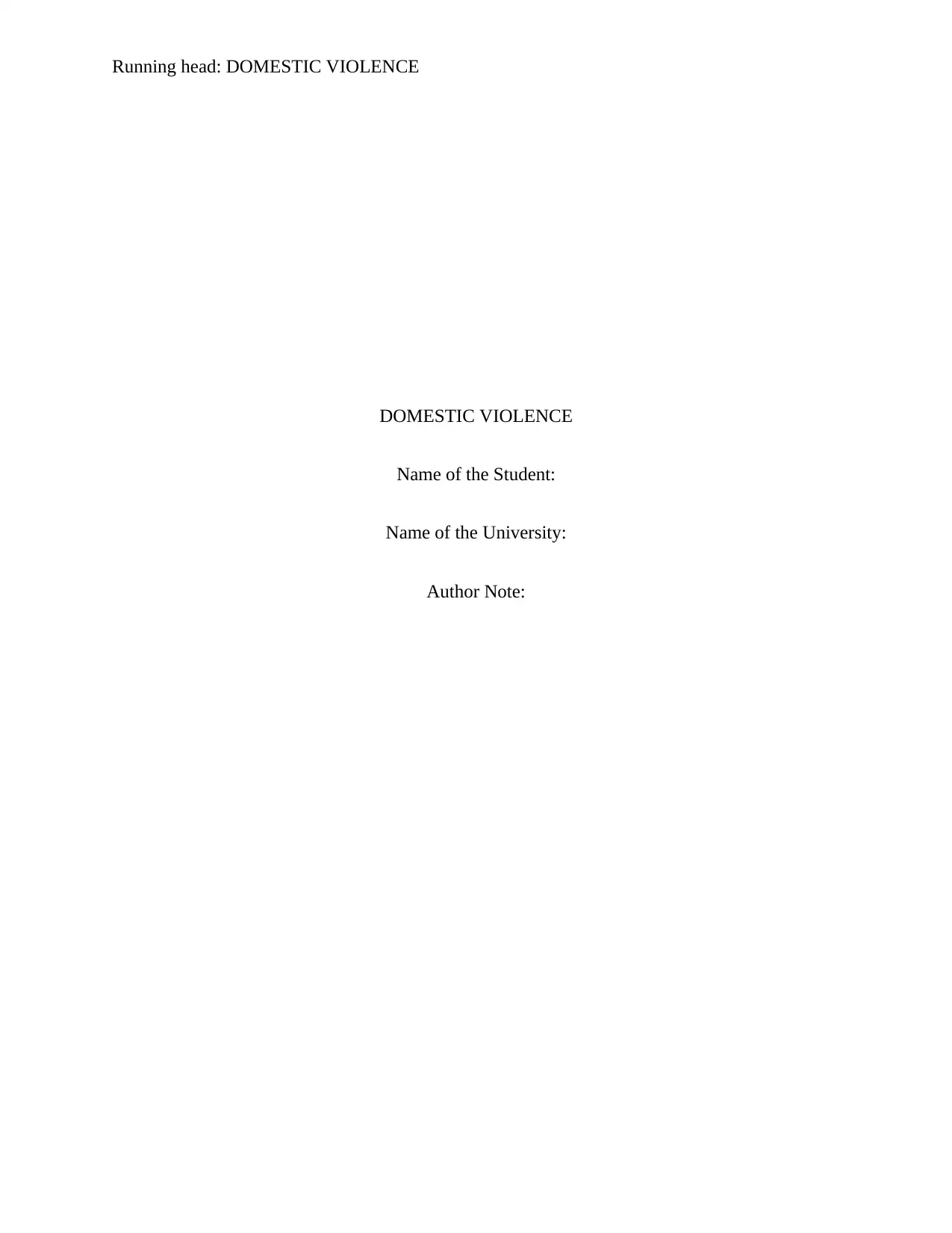
Running head: DOMESTIC VIOLENCE
DOMESTIC VIOLENCE
Name of the Student:
Name of the University:
Author Note:
DOMESTIC VIOLENCE
Name of the Student:
Name of the University:
Author Note:
Paraphrase This Document
Need a fresh take? Get an instant paraphrase of this document with our AI Paraphraser
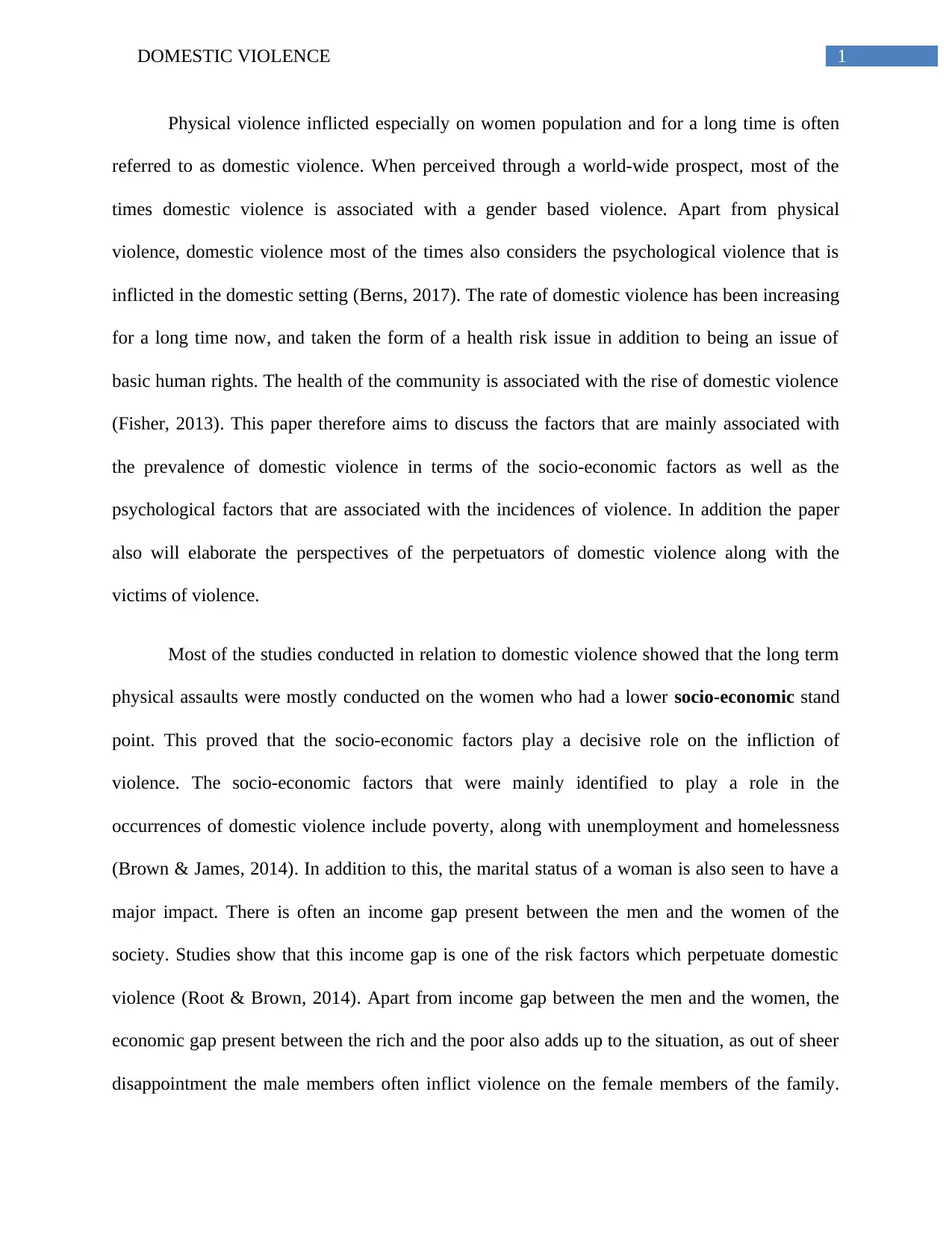
1DOMESTIC VIOLENCE
Physical violence inflicted especially on women population and for a long time is often
referred to as domestic violence. When perceived through a world-wide prospect, most of the
times domestic violence is associated with a gender based violence. Apart from physical
violence, domestic violence most of the times also considers the psychological violence that is
inflicted in the domestic setting (Berns, 2017). The rate of domestic violence has been increasing
for a long time now, and taken the form of a health risk issue in addition to being an issue of
basic human rights. The health of the community is associated with the rise of domestic violence
(Fisher, 2013). This paper therefore aims to discuss the factors that are mainly associated with
the prevalence of domestic violence in terms of the socio-economic factors as well as the
psychological factors that are associated with the incidences of violence. In addition the paper
also will elaborate the perspectives of the perpetuators of domestic violence along with the
victims of violence.
Most of the studies conducted in relation to domestic violence showed that the long term
physical assaults were mostly conducted on the women who had a lower socio-economic stand
point. This proved that the socio-economic factors play a decisive role on the infliction of
violence. The socio-economic factors that were mainly identified to play a role in the
occurrences of domestic violence include poverty, along with unemployment and homelessness
(Brown & James, 2014). In addition to this, the marital status of a woman is also seen to have a
major impact. There is often an income gap present between the men and the women of the
society. Studies show that this income gap is one of the risk factors which perpetuate domestic
violence (Root & Brown, 2014). Apart from income gap between the men and the women, the
economic gap present between the rich and the poor also adds up to the situation, as out of sheer
disappointment the male members often inflict violence on the female members of the family.
Physical violence inflicted especially on women population and for a long time is often
referred to as domestic violence. When perceived through a world-wide prospect, most of the
times domestic violence is associated with a gender based violence. Apart from physical
violence, domestic violence most of the times also considers the psychological violence that is
inflicted in the domestic setting (Berns, 2017). The rate of domestic violence has been increasing
for a long time now, and taken the form of a health risk issue in addition to being an issue of
basic human rights. The health of the community is associated with the rise of domestic violence
(Fisher, 2013). This paper therefore aims to discuss the factors that are mainly associated with
the prevalence of domestic violence in terms of the socio-economic factors as well as the
psychological factors that are associated with the incidences of violence. In addition the paper
also will elaborate the perspectives of the perpetuators of domestic violence along with the
victims of violence.
Most of the studies conducted in relation to domestic violence showed that the long term
physical assaults were mostly conducted on the women who had a lower socio-economic stand
point. This proved that the socio-economic factors play a decisive role on the infliction of
violence. The socio-economic factors that were mainly identified to play a role in the
occurrences of domestic violence include poverty, along with unemployment and homelessness
(Brown & James, 2014). In addition to this, the marital status of a woman is also seen to have a
major impact. There is often an income gap present between the men and the women of the
society. Studies show that this income gap is one of the risk factors which perpetuate domestic
violence (Root & Brown, 2014). Apart from income gap between the men and the women, the
economic gap present between the rich and the poor also adds up to the situation, as out of sheer
disappointment the male members often inflict violence on the female members of the family.
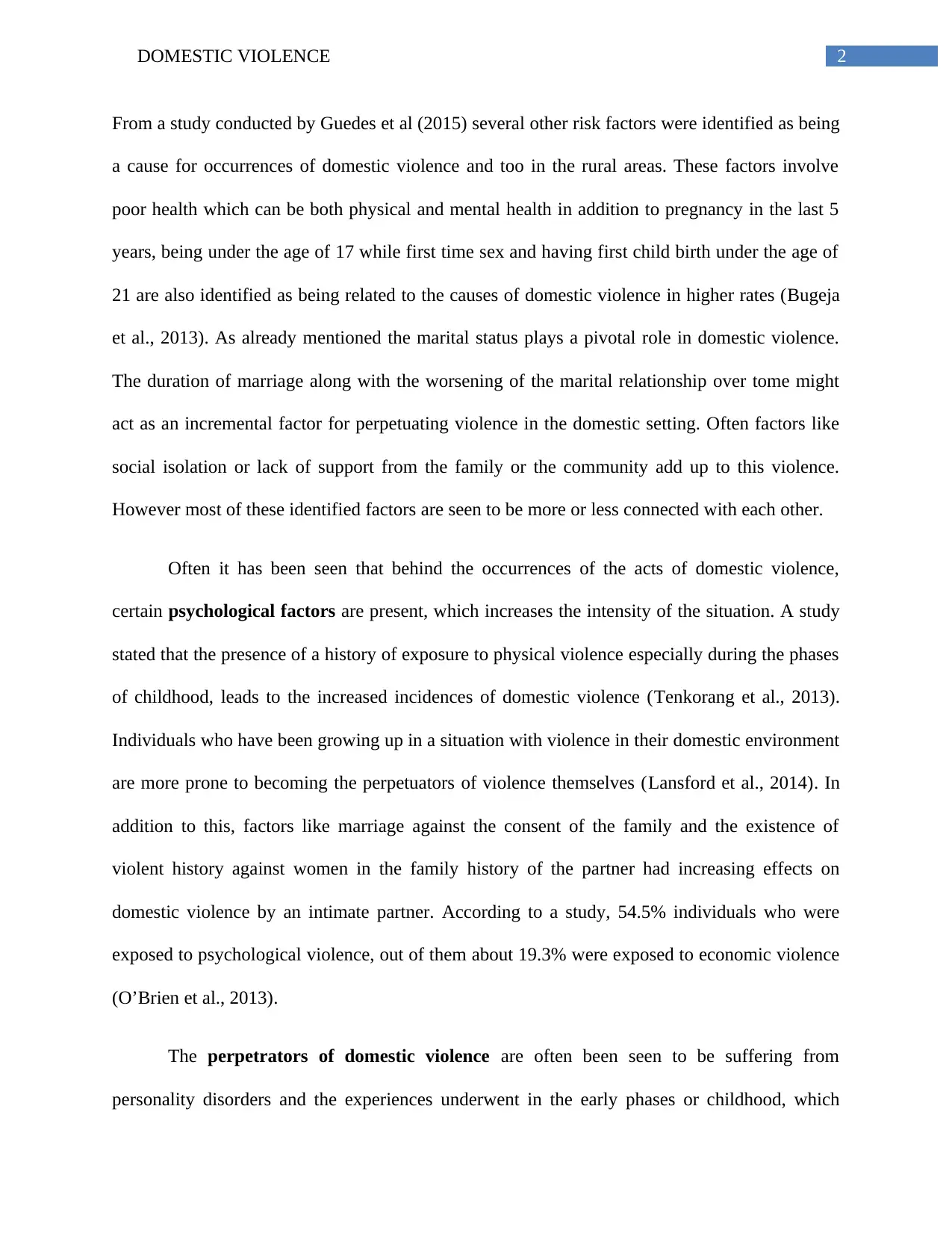
2DOMESTIC VIOLENCE
From a study conducted by Guedes et al (2015) several other risk factors were identified as being
a cause for occurrences of domestic violence and too in the rural areas. These factors involve
poor health which can be both physical and mental health in addition to pregnancy in the last 5
years, being under the age of 17 while first time sex and having first child birth under the age of
21 are also identified as being related to the causes of domestic violence in higher rates (Bugeja
et al., 2013). As already mentioned the marital status plays a pivotal role in domestic violence.
The duration of marriage along with the worsening of the marital relationship over tome might
act as an incremental factor for perpetuating violence in the domestic setting. Often factors like
social isolation or lack of support from the family or the community add up to this violence.
However most of these identified factors are seen to be more or less connected with each other.
Often it has been seen that behind the occurrences of the acts of domestic violence,
certain psychological factors are present, which increases the intensity of the situation. A study
stated that the presence of a history of exposure to physical violence especially during the phases
of childhood, leads to the increased incidences of domestic violence (Tenkorang et al., 2013).
Individuals who have been growing up in a situation with violence in their domestic environment
are more prone to becoming the perpetuators of violence themselves (Lansford et al., 2014). In
addition to this, factors like marriage against the consent of the family and the existence of
violent history against women in the family history of the partner had increasing effects on
domestic violence by an intimate partner. According to a study, 54.5% individuals who were
exposed to psychological violence, out of them about 19.3% were exposed to economic violence
(O’Brien et al., 2013).
The perpetrators of domestic violence are often been seen to be suffering from
personality disorders and the experiences underwent in the early phases or childhood, which
From a study conducted by Guedes et al (2015) several other risk factors were identified as being
a cause for occurrences of domestic violence and too in the rural areas. These factors involve
poor health which can be both physical and mental health in addition to pregnancy in the last 5
years, being under the age of 17 while first time sex and having first child birth under the age of
21 are also identified as being related to the causes of domestic violence in higher rates (Bugeja
et al., 2013). As already mentioned the marital status plays a pivotal role in domestic violence.
The duration of marriage along with the worsening of the marital relationship over tome might
act as an incremental factor for perpetuating violence in the domestic setting. Often factors like
social isolation or lack of support from the family or the community add up to this violence.
However most of these identified factors are seen to be more or less connected with each other.
Often it has been seen that behind the occurrences of the acts of domestic violence,
certain psychological factors are present, which increases the intensity of the situation. A study
stated that the presence of a history of exposure to physical violence especially during the phases
of childhood, leads to the increased incidences of domestic violence (Tenkorang et al., 2013).
Individuals who have been growing up in a situation with violence in their domestic environment
are more prone to becoming the perpetuators of violence themselves (Lansford et al., 2014). In
addition to this, factors like marriage against the consent of the family and the existence of
violent history against women in the family history of the partner had increasing effects on
domestic violence by an intimate partner. According to a study, 54.5% individuals who were
exposed to psychological violence, out of them about 19.3% were exposed to economic violence
(O’Brien et al., 2013).
The perpetrators of domestic violence are often been seen to be suffering from
personality disorders and the experiences underwent in the early phases or childhood, which
⊘ This is a preview!⊘
Do you want full access?
Subscribe today to unlock all pages.

Trusted by 1+ million students worldwide
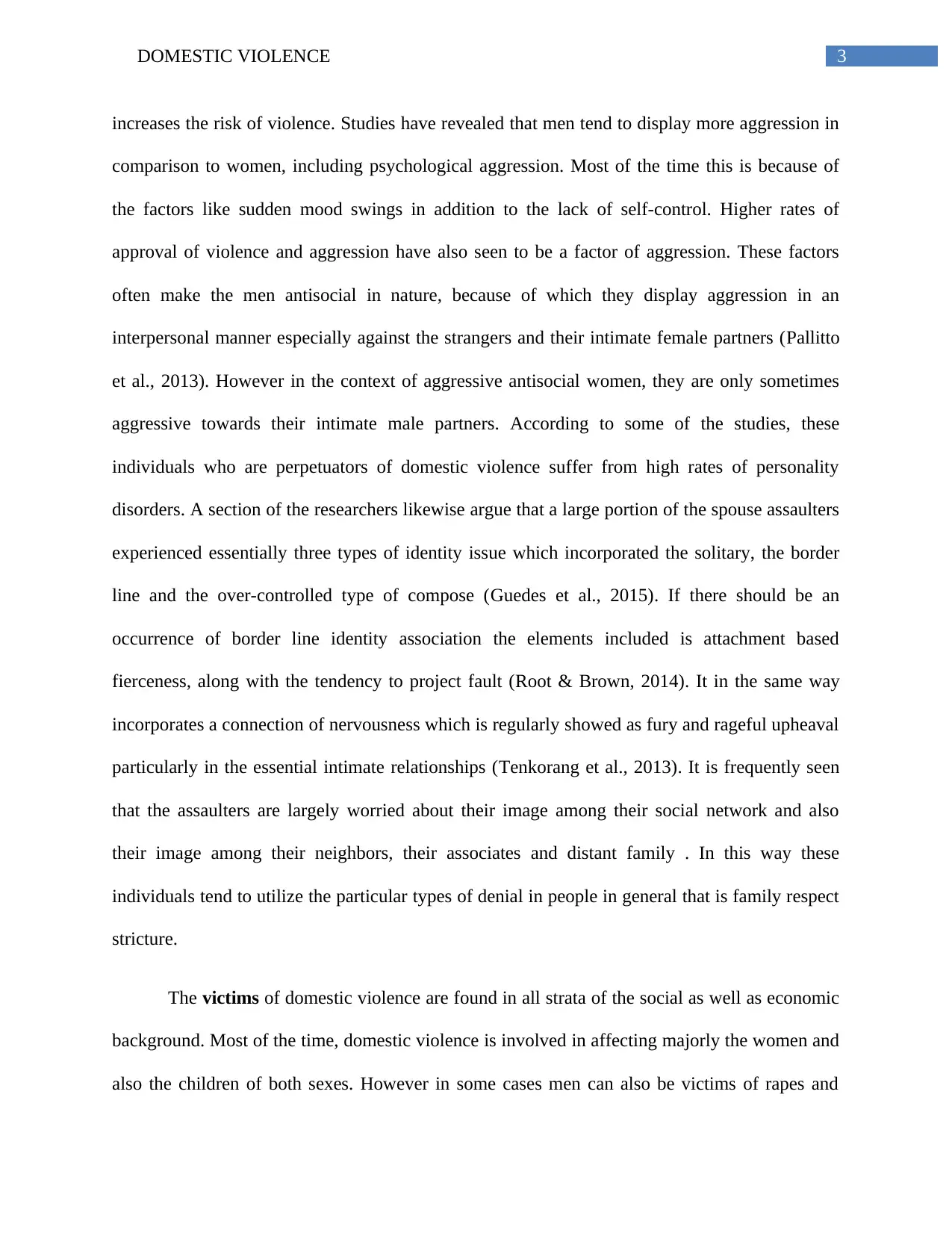
3DOMESTIC VIOLENCE
increases the risk of violence. Studies have revealed that men tend to display more aggression in
comparison to women, including psychological aggression. Most of the time this is because of
the factors like sudden mood swings in addition to the lack of self-control. Higher rates of
approval of violence and aggression have also seen to be a factor of aggression. These factors
often make the men antisocial in nature, because of which they display aggression in an
interpersonal manner especially against the strangers and their intimate female partners (Pallitto
et al., 2013). However in the context of aggressive antisocial women, they are only sometimes
aggressive towards their intimate male partners. According to some of the studies, these
individuals who are perpetuators of domestic violence suffer from high rates of personality
disorders. A section of the researchers likewise argue that a large portion of the spouse assaulters
experienced essentially three types of identity issue which incorporated the solitary, the border
line and the over-controlled type of compose (Guedes et al., 2015). If there should be an
occurrence of border line identity association the elements included is attachment based
fierceness, along with the tendency to project fault (Root & Brown, 2014). It in the same way
incorporates a connection of nervousness which is regularly showed as fury and rageful upheaval
particularly in the essential intimate relationships (Tenkorang et al., 2013). It is frequently seen
that the assaulters are largely worried about their image among their social network and also
their image among their neighbors, their associates and distant family . In this way these
individuals tend to utilize the particular types of denial in people in general that is family respect
stricture.
The victims of domestic violence are found in all strata of the social as well as economic
background. Most of the time, domestic violence is involved in affecting majorly the women and
also the children of both sexes. However in some cases men can also be victims of rapes and
increases the risk of violence. Studies have revealed that men tend to display more aggression in
comparison to women, including psychological aggression. Most of the time this is because of
the factors like sudden mood swings in addition to the lack of self-control. Higher rates of
approval of violence and aggression have also seen to be a factor of aggression. These factors
often make the men antisocial in nature, because of which they display aggression in an
interpersonal manner especially against the strangers and their intimate female partners (Pallitto
et al., 2013). However in the context of aggressive antisocial women, they are only sometimes
aggressive towards their intimate male partners. According to some of the studies, these
individuals who are perpetuators of domestic violence suffer from high rates of personality
disorders. A section of the researchers likewise argue that a large portion of the spouse assaulters
experienced essentially three types of identity issue which incorporated the solitary, the border
line and the over-controlled type of compose (Guedes et al., 2015). If there should be an
occurrence of border line identity association the elements included is attachment based
fierceness, along with the tendency to project fault (Root & Brown, 2014). It in the same way
incorporates a connection of nervousness which is regularly showed as fury and rageful upheaval
particularly in the essential intimate relationships (Tenkorang et al., 2013). It is frequently seen
that the assaulters are largely worried about their image among their social network and also
their image among their neighbors, their associates and distant family . In this way these
individuals tend to utilize the particular types of denial in people in general that is family respect
stricture.
The victims of domestic violence are found in all strata of the social as well as economic
background. Most of the time, domestic violence is involved in affecting majorly the women and
also the children of both sexes. However in some cases men can also be victims of rapes and
Paraphrase This Document
Need a fresh take? Get an instant paraphrase of this document with our AI Paraphraser
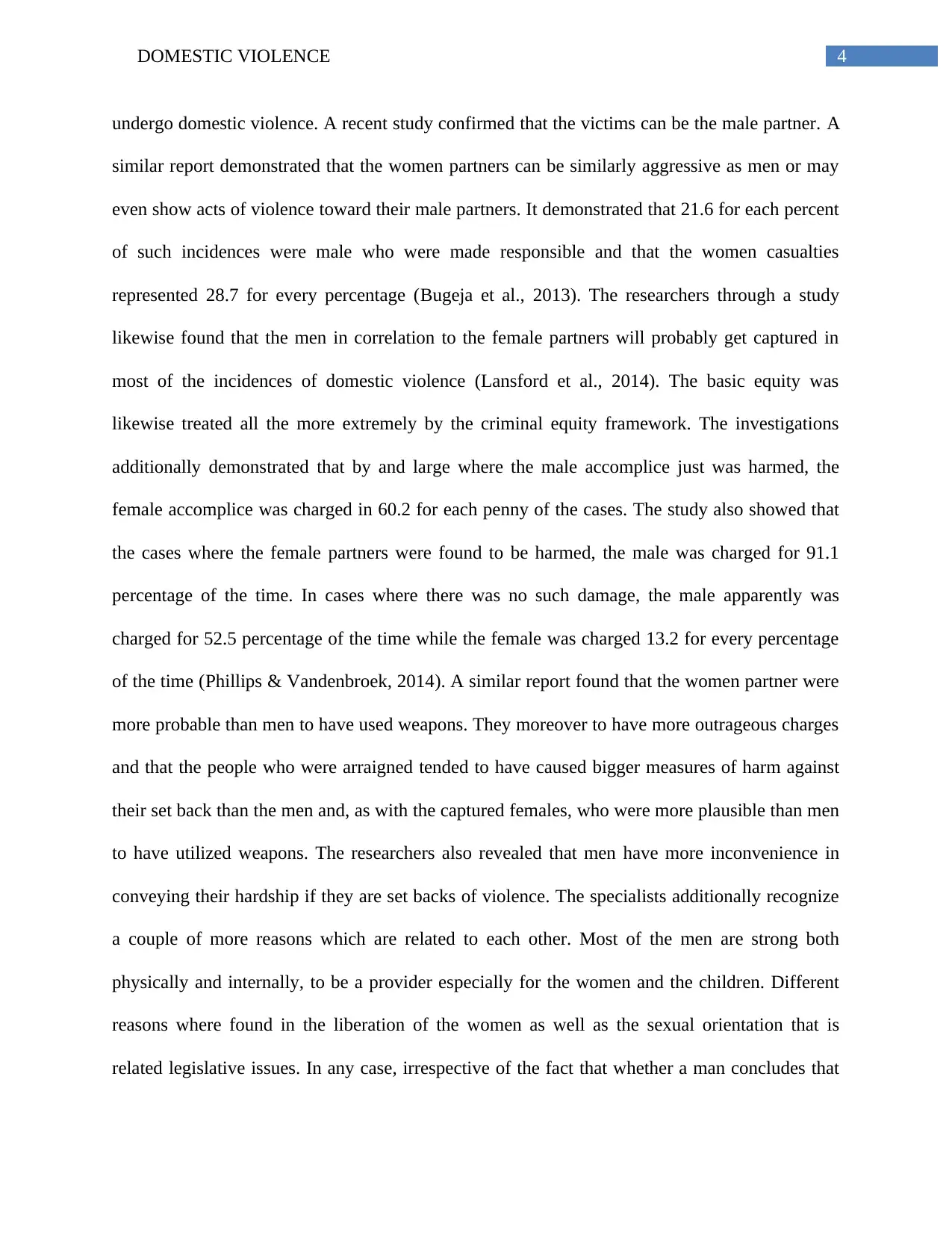
4DOMESTIC VIOLENCE
undergo domestic violence. A recent study confirmed that the victims can be the male partner. A
similar report demonstrated that the women partners can be similarly aggressive as men or may
even show acts of violence toward their male partners. It demonstrated that 21.6 for each percent
of such incidences were male who were made responsible and that the women casualties
represented 28.7 for every percentage (Bugeja et al., 2013). The researchers through a study
likewise found that the men in correlation to the female partners will probably get captured in
most of the incidences of domestic violence (Lansford et al., 2014). The basic equity was
likewise treated all the more extremely by the criminal equity framework. The investigations
additionally demonstrated that by and large where the male accomplice just was harmed, the
female accomplice was charged in 60.2 for each penny of the cases. The study also showed that
the cases where the female partners were found to be harmed, the male was charged for 91.1
percentage of the time. In cases where there was no such damage, the male apparently was
charged for 52.5 percentage of the time while the female was charged 13.2 for every percentage
of the time (Phillips & Vandenbroek, 2014). A similar report found that the women partner were
more probable than men to have used weapons. They moreover to have more outrageous charges
and that the people who were arraigned tended to have caused bigger measures of harm against
their set back than the men and, as with the captured females, who were more plausible than men
to have utilized weapons. The researchers also revealed that men have more inconvenience in
conveying their hardship if they are set backs of violence. The specialists additionally recognize
a couple of more reasons which are related to each other. Most of the men are strong both
physically and internally, to be a provider especially for the women and the children. Different
reasons where found in the liberation of the women as well as the sexual orientation that is
related legislative issues. In any case, irrespective of the fact that whether a man concludes that
undergo domestic violence. A recent study confirmed that the victims can be the male partner. A
similar report demonstrated that the women partners can be similarly aggressive as men or may
even show acts of violence toward their male partners. It demonstrated that 21.6 for each percent
of such incidences were male who were made responsible and that the women casualties
represented 28.7 for every percentage (Bugeja et al., 2013). The researchers through a study
likewise found that the men in correlation to the female partners will probably get captured in
most of the incidences of domestic violence (Lansford et al., 2014). The basic equity was
likewise treated all the more extremely by the criminal equity framework. The investigations
additionally demonstrated that by and large where the male accomplice just was harmed, the
female accomplice was charged in 60.2 for each penny of the cases. The study also showed that
the cases where the female partners were found to be harmed, the male was charged for 91.1
percentage of the time. In cases where there was no such damage, the male apparently was
charged for 52.5 percentage of the time while the female was charged 13.2 for every percentage
of the time (Phillips & Vandenbroek, 2014). A similar report found that the women partner were
more probable than men to have used weapons. They moreover to have more outrageous charges
and that the people who were arraigned tended to have caused bigger measures of harm against
their set back than the men and, as with the captured females, who were more plausible than men
to have utilized weapons. The researchers also revealed that men have more inconvenience in
conveying their hardship if they are set backs of violence. The specialists additionally recognize
a couple of more reasons which are related to each other. Most of the men are strong both
physically and internally, to be a provider especially for the women and the children. Different
reasons where found in the liberation of the women as well as the sexual orientation that is
related legislative issues. In any case, irrespective of the fact that whether a man concludes that
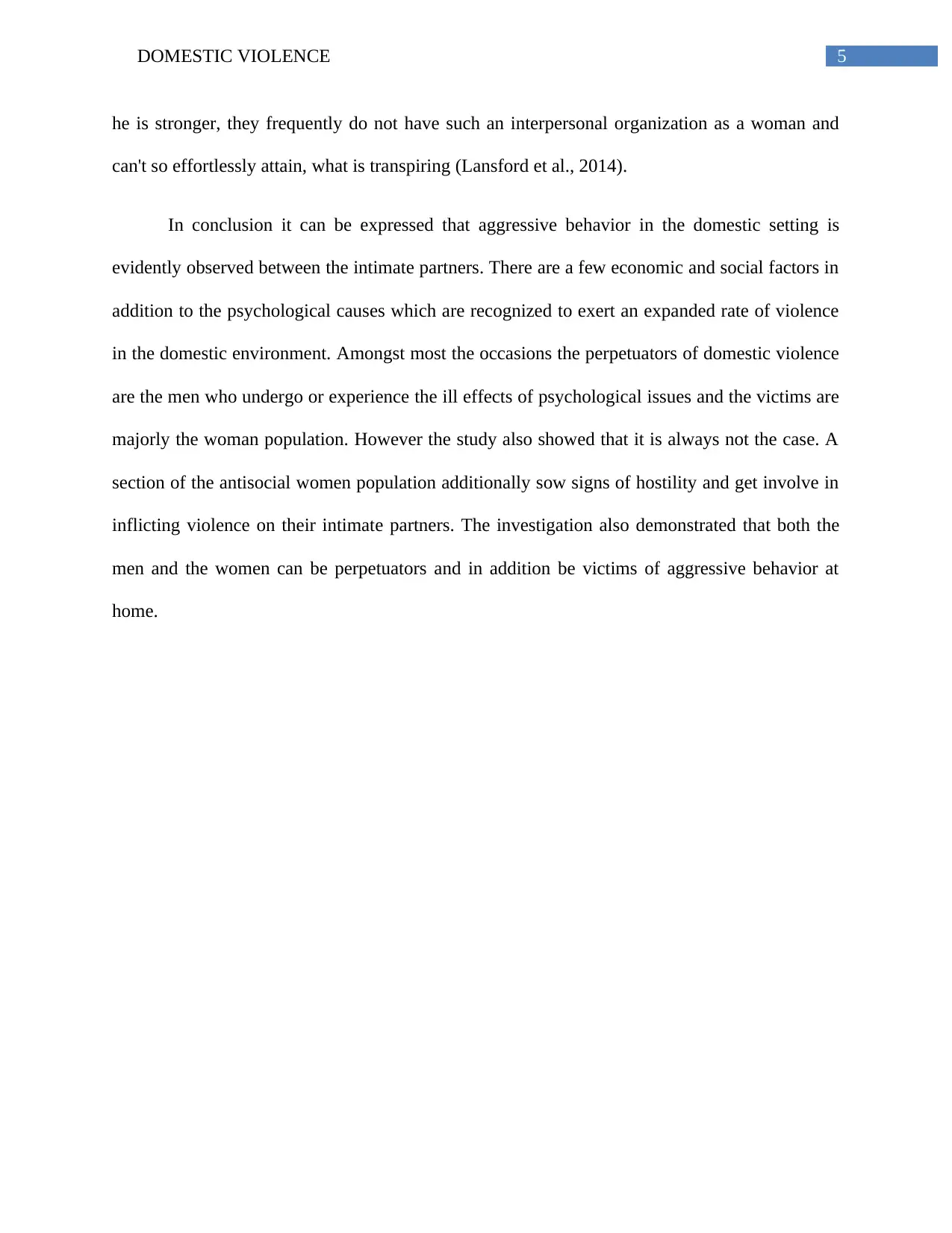
5DOMESTIC VIOLENCE
he is stronger, they frequently do not have such an interpersonal organization as a woman and
can't so effortlessly attain, what is transpiring (Lansford et al., 2014).
In conclusion it can be expressed that aggressive behavior in the domestic setting is
evidently observed between the intimate partners. There are a few economic and social factors in
addition to the psychological causes which are recognized to exert an expanded rate of violence
in the domestic environment. Amongst most the occasions the perpetuators of domestic violence
are the men who undergo or experience the ill effects of psychological issues and the victims are
majorly the woman population. However the study also showed that it is always not the case. A
section of the antisocial women population additionally sow signs of hostility and get involve in
inflicting violence on their intimate partners. The investigation also demonstrated that both the
men and the women can be perpetuators and in addition be victims of aggressive behavior at
home.
he is stronger, they frequently do not have such an interpersonal organization as a woman and
can't so effortlessly attain, what is transpiring (Lansford et al., 2014).
In conclusion it can be expressed that aggressive behavior in the domestic setting is
evidently observed between the intimate partners. There are a few economic and social factors in
addition to the psychological causes which are recognized to exert an expanded rate of violence
in the domestic environment. Amongst most the occasions the perpetuators of domestic violence
are the men who undergo or experience the ill effects of psychological issues and the victims are
majorly the woman population. However the study also showed that it is always not the case. A
section of the antisocial women population additionally sow signs of hostility and get involve in
inflicting violence on their intimate partners. The investigation also demonstrated that both the
men and the women can be perpetuators and in addition be victims of aggressive behavior at
home.
⊘ This is a preview!⊘
Do you want full access?
Subscribe today to unlock all pages.

Trusted by 1+ million students worldwide
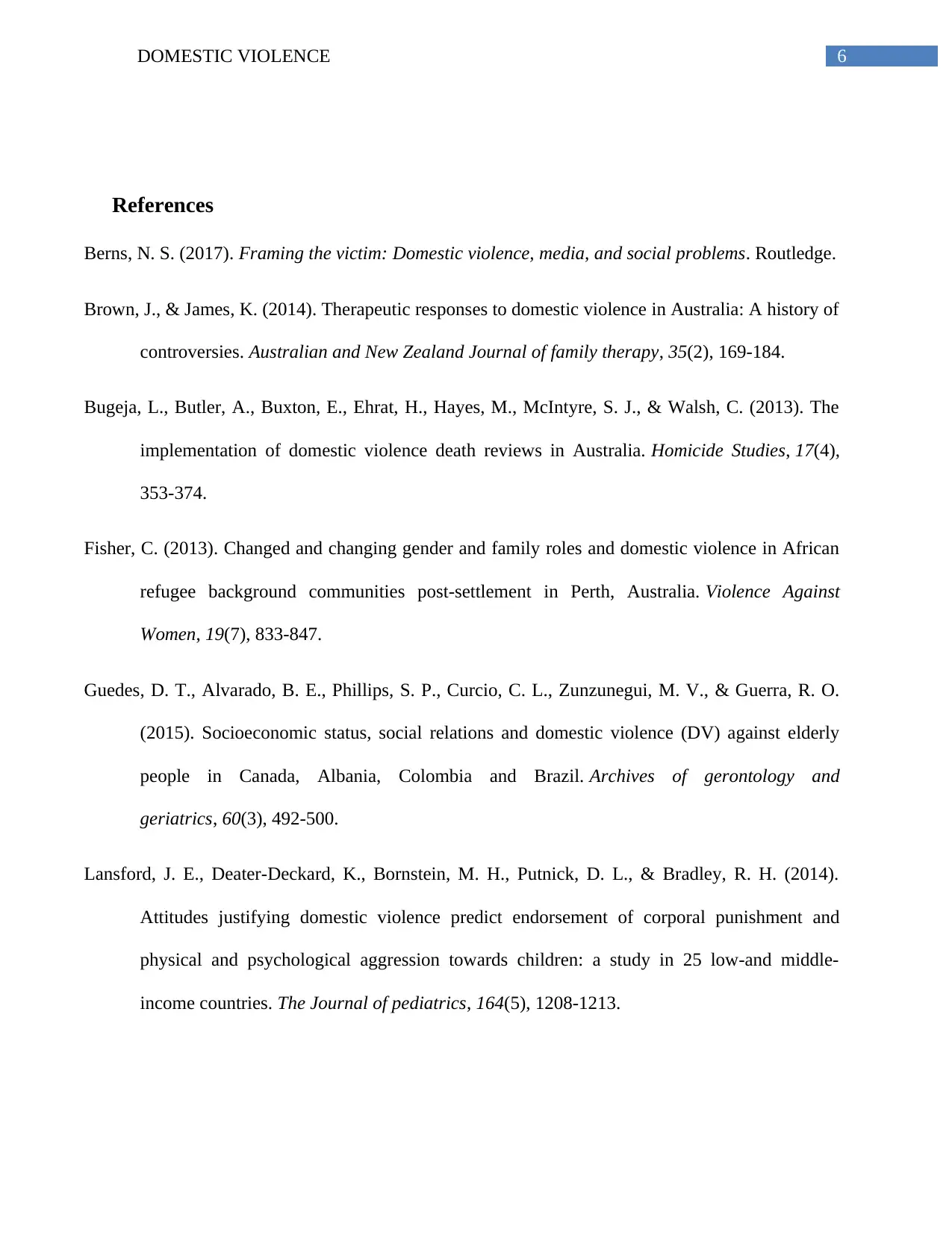
6DOMESTIC VIOLENCE
References
Berns, N. S. (2017). Framing the victim: Domestic violence, media, and social problems. Routledge.
Brown, J., & James, K. (2014). Therapeutic responses to domestic violence in Australia: A history of
controversies. Australian and New Zealand Journal of family therapy, 35(2), 169-184.
Bugeja, L., Butler, A., Buxton, E., Ehrat, H., Hayes, M., McIntyre, S. J., & Walsh, C. (2013). The
implementation of domestic violence death reviews in Australia. Homicide Studies, 17(4),
353-374.
Fisher, C. (2013). Changed and changing gender and family roles and domestic violence in African
refugee background communities post-settlement in Perth, Australia. Violence Against
Women, 19(7), 833-847.
Guedes, D. T., Alvarado, B. E., Phillips, S. P., Curcio, C. L., Zunzunegui, M. V., & Guerra, R. O.
(2015). Socioeconomic status, social relations and domestic violence (DV) against elderly
people in Canada, Albania, Colombia and Brazil. Archives of gerontology and
geriatrics, 60(3), 492-500.
Lansford, J. E., Deater-Deckard, K., Bornstein, M. H., Putnick, D. L., & Bradley, R. H. (2014).
Attitudes justifying domestic violence predict endorsement of corporal punishment and
physical and psychological aggression towards children: a study in 25 low-and middle-
income countries. The Journal of pediatrics, 164(5), 1208-1213.
References
Berns, N. S. (2017). Framing the victim: Domestic violence, media, and social problems. Routledge.
Brown, J., & James, K. (2014). Therapeutic responses to domestic violence in Australia: A history of
controversies. Australian and New Zealand Journal of family therapy, 35(2), 169-184.
Bugeja, L., Butler, A., Buxton, E., Ehrat, H., Hayes, M., McIntyre, S. J., & Walsh, C. (2013). The
implementation of domestic violence death reviews in Australia. Homicide Studies, 17(4),
353-374.
Fisher, C. (2013). Changed and changing gender and family roles and domestic violence in African
refugee background communities post-settlement in Perth, Australia. Violence Against
Women, 19(7), 833-847.
Guedes, D. T., Alvarado, B. E., Phillips, S. P., Curcio, C. L., Zunzunegui, M. V., & Guerra, R. O.
(2015). Socioeconomic status, social relations and domestic violence (DV) against elderly
people in Canada, Albania, Colombia and Brazil. Archives of gerontology and
geriatrics, 60(3), 492-500.
Lansford, J. E., Deater-Deckard, K., Bornstein, M. H., Putnick, D. L., & Bradley, R. H. (2014).
Attitudes justifying domestic violence predict endorsement of corporal punishment and
physical and psychological aggression towards children: a study in 25 low-and middle-
income countries. The Journal of pediatrics, 164(5), 1208-1213.
Paraphrase This Document
Need a fresh take? Get an instant paraphrase of this document with our AI Paraphraser
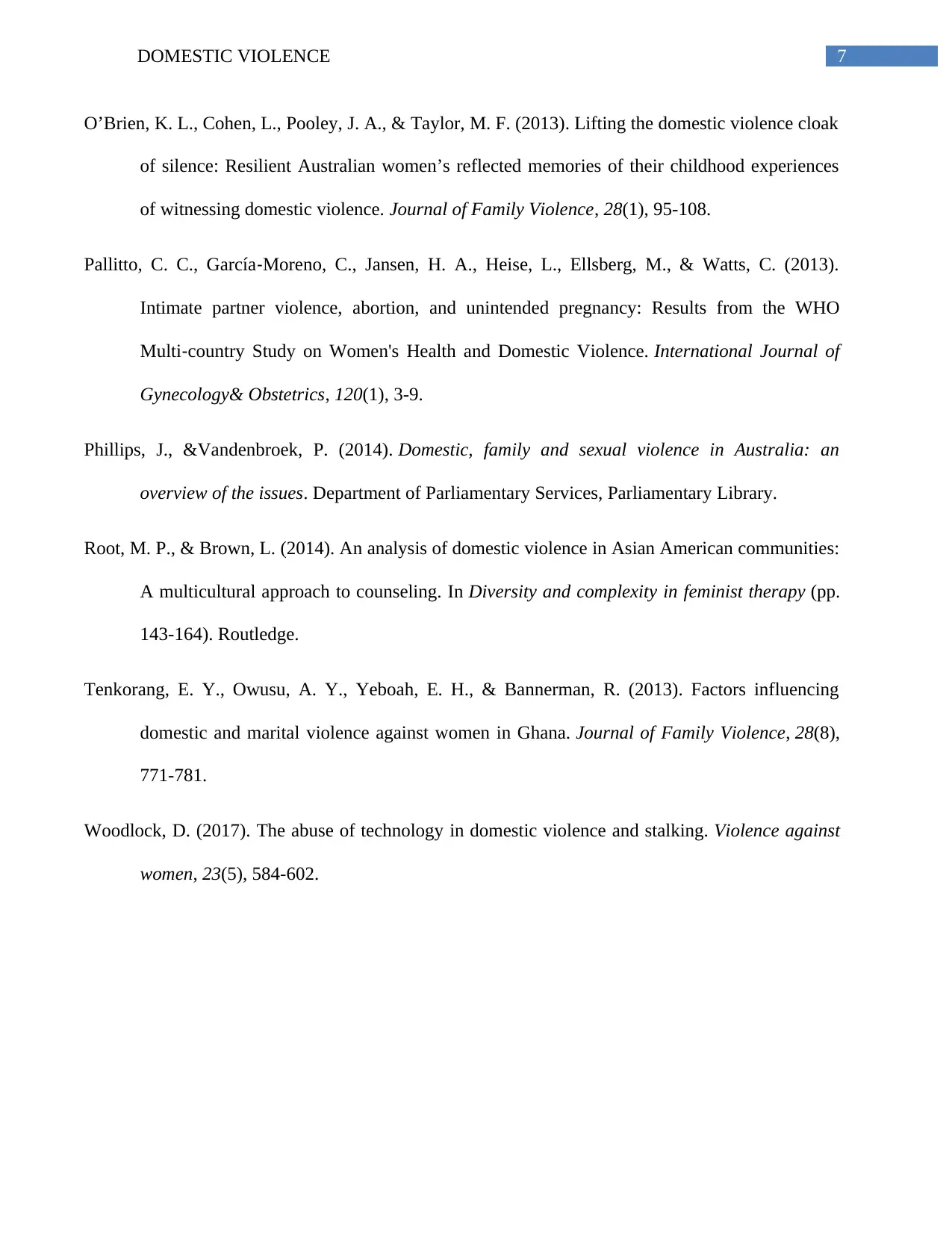
7DOMESTIC VIOLENCE
O’Brien, K. L., Cohen, L., Pooley, J. A., & Taylor, M. F. (2013). Lifting the domestic violence cloak
of silence: Resilient Australian women’s reflected memories of their childhood experiences
of witnessing domestic violence. Journal of Family Violence, 28(1), 95-108.
Pallitto, C. C., García‐Moreno, C., Jansen, H. A., Heise, L., Ellsberg, M., & Watts, C. (2013).
Intimate partner violence, abortion, and unintended pregnancy: Results from the WHO
Multi‐country Study on Women's Health and Domestic Violence. International Journal of
Gynecology& Obstetrics, 120(1), 3-9.
Phillips, J., &Vandenbroek, P. (2014). Domestic, family and sexual violence in Australia: an
overview of the issues. Department of Parliamentary Services, Parliamentary Library.
Root, M. P., & Brown, L. (2014). An analysis of domestic violence in Asian American communities:
A multicultural approach to counseling. In Diversity and complexity in feminist therapy (pp.
143-164). Routledge.
Tenkorang, E. Y., Owusu, A. Y., Yeboah, E. H., & Bannerman, R. (2013). Factors influencing
domestic and marital violence against women in Ghana. Journal of Family Violence, 28(8),
771-781.
Woodlock, D. (2017). The abuse of technology in domestic violence and stalking. Violence against
women, 23(5), 584-602.
O’Brien, K. L., Cohen, L., Pooley, J. A., & Taylor, M. F. (2013). Lifting the domestic violence cloak
of silence: Resilient Australian women’s reflected memories of their childhood experiences
of witnessing domestic violence. Journal of Family Violence, 28(1), 95-108.
Pallitto, C. C., García‐Moreno, C., Jansen, H. A., Heise, L., Ellsberg, M., & Watts, C. (2013).
Intimate partner violence, abortion, and unintended pregnancy: Results from the WHO
Multi‐country Study on Women's Health and Domestic Violence. International Journal of
Gynecology& Obstetrics, 120(1), 3-9.
Phillips, J., &Vandenbroek, P. (2014). Domestic, family and sexual violence in Australia: an
overview of the issues. Department of Parliamentary Services, Parliamentary Library.
Root, M. P., & Brown, L. (2014). An analysis of domestic violence in Asian American communities:
A multicultural approach to counseling. In Diversity and complexity in feminist therapy (pp.
143-164). Routledge.
Tenkorang, E. Y., Owusu, A. Y., Yeboah, E. H., & Bannerman, R. (2013). Factors influencing
domestic and marital violence against women in Ghana. Journal of Family Violence, 28(8),
771-781.
Woodlock, D. (2017). The abuse of technology in domestic violence and stalking. Violence against
women, 23(5), 584-602.
1 out of 8
Related Documents
Your All-in-One AI-Powered Toolkit for Academic Success.
+13062052269
info@desklib.com
Available 24*7 on WhatsApp / Email
![[object Object]](/_next/static/media/star-bottom.7253800d.svg)
Unlock your academic potential
Copyright © 2020–2025 A2Z Services. All Rights Reserved. Developed and managed by ZUCOL.




